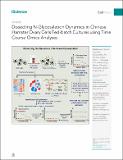Dissecting N-Glycosylation Dynamics in Chinese Hamster Ovary Cells Fed-batch Cultures using Time Course Omics Analyses
Author(s)
Sumit, Madhuresh; Dolatshahi, Sepideh; Chu, An-Hsiang Adam; Cote, Kaffa; Scarcelli, John J.; Marshall, Jeffrey K.; Cornell, Richard J.; Weiss, Ron; Lauffenburger, Douglas A.; Mulukutla, Bhanu Chandra; Figueroa, Bruno; ... Show more Show less
DownloadPublished version (10.95Mb)
Publisher with Creative Commons License
Publisher with Creative Commons License
Creative Commons Attribution
Terms of use
Metadata
Show full item recordAbstract
N-linked glycosylation affects the potency, safety, immunogenicity, and pharmacokinetic clearance of several therapeutic proteins including monoclonal antibodies. A robust control strategy is needed to dial in appropriate glycosylation profile during the course of cell culture processes accurately. However, N-glycosylation dynamics remains insufficiently understood owing to the lack of integrative analyses of factors that influence the dynamics, including sugar nucleotide donors, glycosyltransferases, and glycosidases. Here, an integrative approach involving multi-dimensional omics analyses was employed to dissect the temporal dynamics of glycoforms produced during fed-batch cultures of CHO cells. Several pathways including glycolysis, tricarboxylic citric acid cycle, and nucleotide biosynthesis exhibited temporal dynamics over the cell culture period. The steps involving galactose and sialic acid addition were determined as temporal bottlenecks. Our results show that galactose, and not manganese, is able to mitigate the temporal bottleneck, despite both being known effectors of galactosylation. Furthermore, sialylation is limited by the galactosylated precursors and autoregulation of cytidine monophosphate-sialic acid biosynthesis.
Date issued
2019-02Department
Massachusetts Institute of Technology. Department of Biological EngineeringJournal
iScience
Publisher
Elsevier BV
Citation
Sumit, Madhuresh et al. "Dissecting N-Glycosylation Dynamics in Chinese Hamster Ovary Cells Fed-batch Cultures using Time Course Omics Analyses." iScience 12 (February 2019): P102-120 © 2019 The Authors
Version: Final published version
ISSN
2589-0042